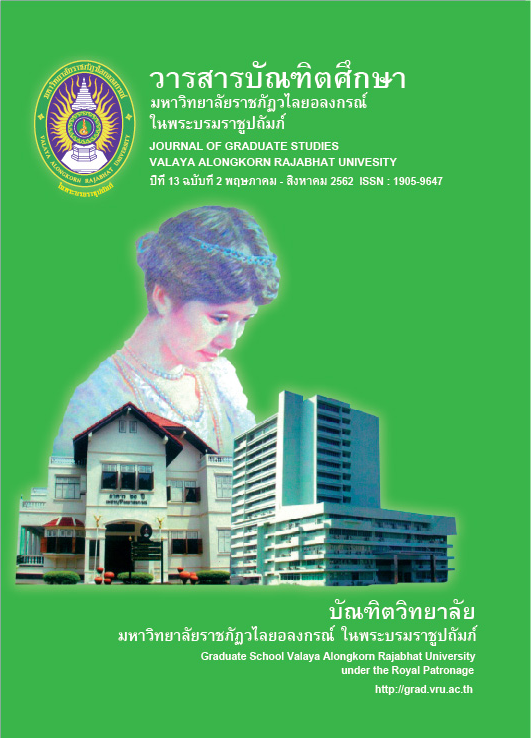AN EVALUATION OF SOCIAL SERVICE FOR THE ELDERLY IN LOCAL ADMINISTRATIVE ORGANIZATIONS IN NARATHIWAT PROVINCE
Main Article Content
Abstract
The objectives of this research were 1) to study the relationship between contexts, input factors, process, outputs and social service management for the elderly in the area of local Administrative Organizations in Narathiwat province, and 2) to study problems, obstacles and solutions for social services for the elderly in Narathiwat local Administrative Organizations. The research methodology used in this study was mixed method. The samples for this research consisted of 11 Municipalities local Administrative Organization of Narathiwat province. The sample group was selected by multi stage sampling technique comprised of the chief executives of Narathiwat local Administrative Organizations, the officers who were responsible for providing social services to the elderly, community leaders, the representatives of the communities and the elderly in Narathiwat local Administrative Organizations. The data were collected by interviewing 78 key informants, and the sample consisted of 416 respondents. The tools used in this research were 5- level rating scale questionnaire. The data were analyzed using statistical composed of percentage mean, standard deviation and t-test. The qualitative research was concluded by in-depth interviewing, and the data were analyzed using the content analysis of opinions on the context, inputs, process, outputs and social service management for the elderly in local Administrative Organizations in Narathiwat province.
The research findings revealed that:
1. The context of the input factors and the process of outputs influenced the provision of social services to the elderly in local Administrative Organizations in Narathiwat province. The process and outputs had direct influence on the provision of social services to the elderly in Narathiwat local Administrative Organizations. The input factors had a direct influence on the process and the outputs of social services for the elderly in Narathiwat local Administrative Organizations. The process and outputs had a direct influence on the provision of social services to the elderly of Narathiwat local Administrative Organizations. According to the study, it was found that the opinions of all latent variables were at a high level (5 levels). In terms of input factors, the average was 4.03. The average of the process was 4.04. The average of the process was 4.02. The average of social services for the elderly of Narathiwat local Administrative Organizations was 4.07, and the path coefficient was 0.196 (t = 4.734, p <.01).
2. In terms of service management at the municipality office, the elderly who were Buddhist and Islamic, the service time were separate for convenience reasons. The elderly had different convenience time. The municipality offices organized the project without elaborating the details of the project to the elderly. Some elderly lacked of knowledges about law and rules of the municipality because they were illiterate. Moreover, the municipalities rarely organized the projects which brought about the elderly did not know the regulations of the municipalities.
Article Details
บทความทุกเรื่องได้รับการตรวจความถูกต้องทางวิชาการโดยผู้ทรงคุณวุฒิ ทรรศนะและข้อคิดเห็นในบทความวารสารบัณฑิตศึกษา มหาวิทยาลัยราชภัฏวไลยอลงกรณ์ ในพระบรมราชูปถัมภ์ มิใช่เป็นทรรศนะและความคิดของผู้จัดทำจึงมิใช่ความรับผิดชอบของบัณฑิตวิทยาลัย มหาวิทยาลัยราชภัฏวไลยอลงกรณ์ ในพระบรมราชูปถัมภ์ กองบรรณาธิการไม่สงวนสิทธิ์การคัดลอก แต่ให้อ้างอิงแหล่งที่มา
References
Byrne, B. M. (1989). A primer of LISREL: Basic applications and programming for confirmatory factor analytic models. New York: Springer-Verlag.
Garson, D. (2012). Structural equation modeling. North Carolina, NC: Statistical Associates Publishing.
Hair, J. F., et al. (2006). Multivariant data analysis. New Jersey: Pearson International Edition.
Hinkle, D. E., et al. (1998). Applied statistics for the behavior sciences (4thed.). New York: Houghton Mifflin.
Hu, L. T., & Betler, P. M. (1999). Cutoff criteria for fit indexes in covariance structure analysis: Conventional criteria versus new alternatives. Structural Equation Modeling: A Multidisciplinary Journal, 6(1), 1-55.
Kruathep, W. (2005). nawattakam sāngsan khō̜ng ʻongkō̜n pokkhrō̜ng sūan thō̜ngthin [Creative Innovation of Local Government Organizations]. Bangkok: Thailand Research Fund.
Lakhamkaew, W. (2015). kānphatthanā rūpbǣp kānbō̜rihān čhatkān phū sūngʻāyu Thai nai thotsawat nā (Phō̜.Sō̜. sō̜ngphanhārō̜ihoksip - 2569) [The Development of a Management Model for the Thai Elderly in the Next Decade (2017-2026]. Doctor of Philosophy, Human Resource Development, Graduate School, Ramkhamhaeng University.
Ministry of Public Health. (2007). khūmư̄ kāndūlǣ songsœ̄m sukkhaphāp phū sūngʻāyu [Elderly Health Care Promotion Guide]. Bangkok: Transportation Organization.
Ministry of Social Development and Human Security. (2013). yutthasāt khwāmmankhong khō̜ng manut Phō̜.Sō̜. sō̜ngphanhārō̜ihāsiphok - sō̜ngphanhārō̜ihoksiphok [Human Security Strategy, 2013-2023]. Bangkok: Ministry of Social Development and Human Security.
Office of the National Economic and Social Development Council. (2013). kān khāt pramān prachākō̜n khō̜ng prathēt Thai Phō̜.Sō̜. sō̜ngphanhārō̜ihāsipsām - 2583 [Population Estimation of Thailand, 2010-2040]. Bangkok: Office of the National Economic and Social Development Board.
Prachuabmueng, W. (2013). rāingān kānsưksā khrōngkān tittām læ pramœ̄nphon kāndamnœ̄n ngān tām phǣn phū sūngʻāyu hǣng chāt chabap thī sō̜ng (Phō̜.Sō̜. sō̜ngphanhārō̜isīsiphā - sō̜ngphanhārō̜ihoksipsī) raya thī sō̜ng (Phō̜.Sō̜. sō̜ngphanhārō̜ihāsip - sō̜ngphanhārō̜ihāsipsī) . [The Study Report on the Follow-up and Evaluation Project of the
National Elderly Plan No. 2 (2002-2021) Phase 2 (2007-2011)]. Bangkok: College of Population Studies, Chulalongkorn University.
Rattanadilok Na Phuket, P. (2013). čhāk panhāsū nayōbāi : kō̜ranī sưksā phū sūngʻāyu nai čhangwat chāidǣn tai [From Problems to Policy : A Case Study of the Elderly in Southern Border Provinces]. Journal of Rom Phruek Journal Krirk University, 31 (3), pp. 1-26.
Schumacker, R. E., & Lomax, R. (2004). A beginner’s guide to structural equation modeling. Mahwah, NJ: Lawrence Erlbaum Associates.
Stufflebeam, D. L. (2001). Evaluation models new direction for evaluation. San Francisco: Jossey Bass.
Sungnoen, K. (2011). Kānwikhro̜patčhaidūai SPSS læ AMOS phư̄akānwičhai [Factor Analysis with SPSS and AMOS for Research]. Bangkok: SE-EDUCATION.
Thai Elderly Research and Development Institute Foundation. (2014). sathānakān phū sūngʻāyu Thai Phō̜.Sō̜. sō̜ngphanhārō̜ihāsipčhet [The situation of Thai elderly in 2014]. Bangkok: Amarin Printing and Publishing.

